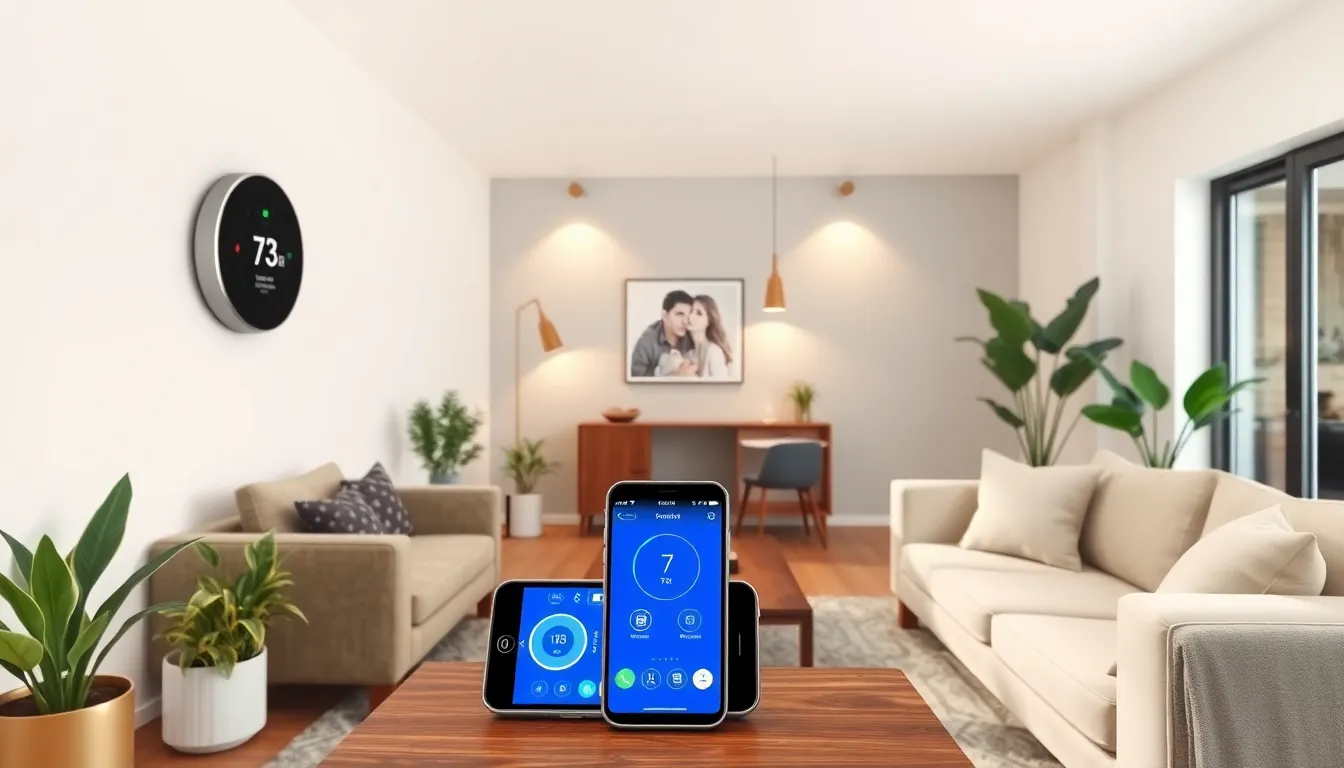Imagine walking into your home and having it greet you like an old friend. That’s the magic of the Internet of Things (IoT) in smart homes. With everything from fridges that can order groceries to lights that adjust based on your mood, these gadgets are not just cool—they’re making life easier and more fun.
Table of Contents
ToggleOverview of IoT in Smart Homes
Smart homes utilize IoT technology to improve daily living experiences. Devices connect seamlessly to the internet, allowing for remote access and control. Homeowners can monitor energy usage with smart meters, which optimize utility consumption. Security systems equipped with cameras enable homeowners to view live feeds from anywhere.
Smart appliances also play a significant role. Refrigerators can manage groceries efficiently, sending alerts for expiry dates while suggesting recipes based on available ingredients. Thermostats learn user preferences, adjusting temperatures automatically for comfort and energy savings.
Lighting systems contribute to ambiance, allowing for color and brightness adjustments via smartphones or voice commands. Automated systems can create schedules for lights, aligning with daily routines or moods. Smart locks enhance security by providing keyless entry and remote locking capabilities.
Moreover, health devices, such as smart air quality monitors, maintain optimal living conditions. Sensors detect pollutants or allergens, alerting homeowners to take action. Integration of wearables enables real-time tracking of personal health metrics.
Collaboration among devices ensures they work harmoniously. Smart home platforms facilitate communication between appliances, enhancing overall efficiency. Through voice assistants, users can manage multiple devices with simple commands, simplifying interactions.
Effective integration of IoT technology significantly enhances comfort and security in smart homes. Trust in these innovations continues to grow as they prove their ability to make everyday tasks easier and more efficient.
Benefits of IoT in Smart Homes

The integration of IoT in smart homes offers numerous benefits that enhance daily living experiences.
Enhanced Convenience
Smart home technology provides ease through centralized control of various devices. Appliances like refrigerators can monitor inventory and suggest grocery lists, turning mundane tasks straightforward. Lighting systems adjust automatically based on user preferences, allowing for personalized ambiance. Voice commands simplify accessibility for individuals with mobility challenges, creating an inclusive environment. Homeowners stay informed with notifications about security and energy consumption, fostering peace of mind. Users can manage everything remotely via smartphones, enhancing the comfort of home living.
Improved Energy Efficiency
IoT devices contribute significantly to energy efficiency in homes. Smart thermostats learn user behaviors, optimizing heating and cooling schedules for maximum cost savings. Energy consumption is monitored in real time, allowing users to make small adjustments that lead to big savings. Systems monitor peak usage and suggest time-shifting strategies to reduce costs. Automated lighting ensures that lights turn off in unoccupied rooms, preventing unnecessary waste. These adjustments together create a more sustainable living environment while lowering utility bills effectively.
Key Components of IoT in Smart Homes
Smart homes rely on several key components to maximize functionality and improve daily living experiences. Integrating various devices and systems creates a seamless, interactive environment.
Smart Devices and Appliances
Smart devices and appliances form the backbone of IoT in smart homes. These include smart refrigerators that manage grocery stocks and alert users about expiration dates. Specific examples involve ovens capable of preheating while users are on their way home. Smart thermostats learn user habits, making automatic adjustments based on preferences. Smart lighting systems offer customizable brightness and color options through apps or voice commands. Furthermore, health devices, such as air quality monitors, detect indoor pollutant levels, ensuring a healthier living space. Such technology enhances convenience, making daily tasks more manageable.
Home Automation Systems
Home automation systems centralize control for various smart devices. These platforms allow efficient communication between devices, creating a cohesive ecosystem. Homeowners can use smartphones or voice assistants to manage lighting, security cameras, and appliances. This integration supports routines, enabling automated actions based on time or conditions, such as adjusting temperatures or turning off lights when no one is home. Increased synergy among devices enhances security measures, with real-time alerts for unusual activity. Overall, home automation systems simplify daily tasks, making smart homes more user-friendly and intuitive.
Challenges and Considerations
Smart homes utilizing IoT face several challenges that require attention.
Security Concerns
Cybersecurity threats represent a significant challenge for smart homes. Many devices connect to the internet, exposing them to potential hacking attempts. Unauthorized access can lead to privacy breaches or manipulation of home systems. Security vulnerabilities in devices or platforms increase risks. Regular software updates act as a critical defense against these threats. Homeowners must use strong, unique passwords for all devices to enhance security. Additionally, the implementation of two-factor authentication provides an extra layer of protection, reducing the chance of unauthorized access.
Interoperability Issues
Interoperability issues arise when different devices and platforms fail to communicate seamlessly. Many manufacturers offer various proprietary systems, creating compatibility challenges. Devices from one brand may not function well with those from another, limiting a smart home’s overall functionality. Standardization of protocols can facilitate better integration. Homeowners benefit from selecting devices compatible with established systems, ensuring smoother communication. Centralized platforms help manage diverse devices, promoting efficiency and usability. Prioritizing interoperability in the selection process leads to a more cohesive smart home experience.
Future Trends in IoT for Smart Homes
Advancements in IoT technology will drive the evolution of smart homes over the next few years. Increased adoption of artificial intelligence enhances device learning capabilities, allowing personalization of user experiences. Smart sensors will improve their ability to track environmental factors, leading to safer and more comfortable living conditions.
More manufacturers are emphasizing interoperability among devices to ensure seamless integration. Efforts to standardize protocols across platforms mean that homeowners should enjoy a cohesive smart home experience. Devices like smart appliances will increasingly collaborate to streamline daily tasks, making life easier.
Energy management systems will evolve with smarter algorithms that analyze usage patterns. Homeowners can experience greater control over energy consumption, resulting in lower utility bills and reduced environmental impact. The trend towards renewable energy sources will further integrate with smart home systems, enabling efficient energy distribution.
Security innovations will develop alongside increasing concerns about privacy and data protection. Enhanced encryption techniques will safeguard personal data while maintaining device functionality. Solutions like advanced facial recognition and motion detection will bolster home security measures.
Health monitoring within smart homes will gain prominence. Integration of wearables with home systems offers residents insights into their well-being, allowing proactive health management. As air quality detection becomes more sophisticated, homes can maintain optimal living environments automatically.
Voice-activated systems will continue to become more intuitive. Homeowners will command systems effortlessly, controlling everything from lighting to thermostats. The rise of virtual reality interfaces may further redefine how users interact with their smart home environments.
Innovative designs for smart home devices will prioritize aesthetic appeal and functionality. This development will encourage homeowners to embrace and enhance their living spaces. As a result, the combination of convenience, efficiency, and security positions IoT technology as an integral part of future homes.
The future of smart homes powered by IoT technology is bright and full of potential. As homeowners embrace these innovations, they’ll enjoy increased convenience and enhanced security in their daily lives. The seamless integration of smart devices not only optimizes energy consumption but also creates a more sustainable living environment.
While challenges like cybersecurity and interoperability remain, ongoing advancements in technology promise to address these issues effectively. With the rise of artificial intelligence and smarter algorithms, personalized experiences will become the norm. Ultimately, IoT will transform homes into intelligent spaces that prioritize comfort, efficiency, and safety, making it an essential aspect of modern living.





